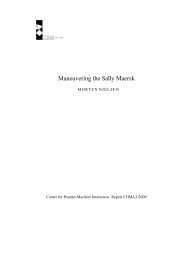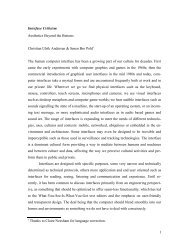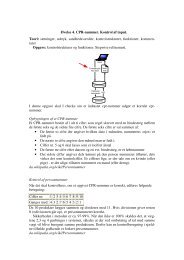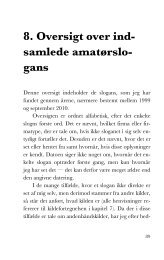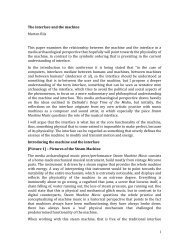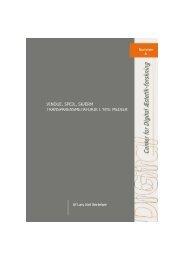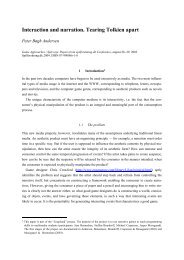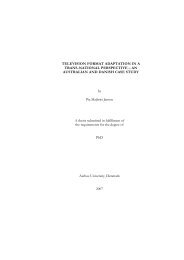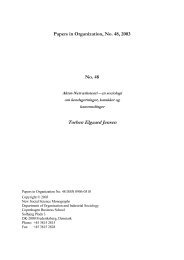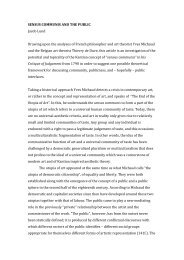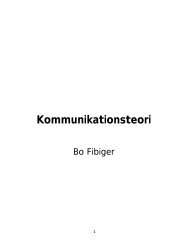Cohesion and Coherence in Programs
Cohesion and Coherence in Programs
Cohesion and Coherence in Programs
You also want an ePaper? Increase the reach of your titles
YUMPU automatically turns print PDFs into web optimized ePapers that Google loves.
Computational signs 1<br />
<strong>Cohesion</strong> <strong>and</strong> <strong>Coherence</strong> <strong>in</strong> <strong>Programs</strong><br />
P E T E R B Ø G H A N D E R S E N , D E P A R T M E N T O F C O M P U T E R<br />
S C I E N C E , U N I V E R S I T Y O F A A L B O R G .<br />
1. Introduction<br />
I first met Mihai Nad<strong>in</strong> <strong>in</strong> 1996 where we arranged a sem<strong>in</strong>ar on <strong>in</strong>formatics<br />
<strong>and</strong> semiotics at Dagstuhl (Germany) together with Frieder Nake (Bremen),<br />
although I was acqua<strong>in</strong>ted with his writ<strong>in</strong>gs, <strong>in</strong> particular Nad<strong>in</strong> (1988) which<br />
I had used for teach<strong>in</strong>g purposes for several years.<br />
Among his many <strong>in</strong>terests were the triad computers, aesthetics, <strong>and</strong> semiotics,<br />
which also happened to belong to my favorite obsessions. The motivation<br />
for this particular assemblage was a particular view on computers,<br />
namely that they were a new medium <strong>and</strong>, consequently, that the aesthetic aspect<br />
was as important <strong>in</strong> computers as <strong>in</strong> any other medium. However, <strong>in</strong> the<br />
early eighties, computers belonged to the realm of the technical <strong>and</strong> natural<br />
sciences, whereas aesthetics was copyrighted by the humanities. Furthermore,<br />
the technology of that time did not appear as a medium, but rather as a tool or<br />
an automaton. However, the later advent of multimedia <strong>and</strong> virtual reality <strong>and</strong><br />
the explosion of the World Wide Web changed this situation, <strong>and</strong> today everybody<br />
talks about the “computer medium” as someth<strong>in</strong>g self-evident.<br />
We had both hit upon semiotics <strong>and</strong> the concept of sign as a possibility for<br />
transgress<strong>in</strong>g the borderl<strong>in</strong>es between the faculties:<br />
There is a physical reality to any sign (...), <strong>and</strong> there is a mental process associated<br />
with it. Sometimes the balance is <strong>in</strong>cl<strong>in</strong>ed towards the physicality of signs, a<br />
other times towards the mental aspects. Nad<strong>in</strong> 1993: 222.<br />
This duality makes semiotics an <strong>in</strong>herently <strong>in</strong>terdiscipl<strong>in</strong>ary field which enables<br />
pr<strong>in</strong>cipled reason<strong>in</strong>g across the faculty borders. And this <strong>in</strong>terdiscipl<strong>in</strong>arity<br />
is necessary for educational as well as for developmental purposes:<br />
In addition, as already stated, the aesthetics cannot be improved after the VR<br />
context is created, i.e. after decisions regard<strong>in</strong>g the nature of representations used<br />
have been made. They have to grow together, <strong>in</strong>tertw<strong>in</strong>ed, <strong>in</strong> order to facilitate the<br />
much desired effectiveness of the experience. Nad<strong>in</strong> 1995: 179.
Computational signs 2<br />
Thus, there is ample motivation for apply<strong>in</strong>g a semiotic perspective to the<br />
computer medium. In 1988 Nad<strong>in</strong> suggested a semiotic analysis of the user<br />
<strong>in</strong>terface of computers as displayed <strong>in</strong> Fig. 1.<br />
Representamen<br />
User <strong>in</strong>terface <strong>and</strong> applications<br />
Object<br />
Types of computer<br />
system (Office, CAD,<br />
Videotext, etc.)<br />
Interpretant<br />
The conditions for use <strong>and</strong> evaluation<br />
Fig. 1. The <strong>in</strong>terface sign.<br />
His <strong>in</strong>terface concept was very broad, <strong>and</strong> <strong>in</strong> particular <strong>in</strong>cluded programm<strong>in</strong>g<br />
environments too: programmers were also users of computer systems.<br />
Fig. 1 is fairly <strong>in</strong>tuitive <strong>and</strong> easy to use, but this was def<strong>in</strong>itely not the last<br />
word about computer based signs. They had many surprises <strong>in</strong> store. It turned<br />
out that computers are more than just a new tool or a new medium. As the<br />
Danish <strong>in</strong>ventor of Algol, Peter Naur early realized, a computer program can<br />
be said to embody a theory, <strong>and</strong> programm<strong>in</strong>g shares many features with theory-build<strong>in</strong>g.<br />
This idea of an embodied theory lies at the heart of Nad<strong>in</strong>’s<br />
concept of “computational design”:<br />
Doch im Gegensatz zu Bleistift, P<strong>in</strong>sel, Messer, Holz- oder Metalltypen, W<strong>in</strong>kelhaken<br />
usw., die Designer <strong>in</strong> der Vergangenheit benutzten, verkörpern diese Programme<br />
bereits e<strong>in</strong>e komprimierte Theorie der Tätigkeit, die sie unterstützen oder<br />
neu erf<strong>in</strong>den (...)<br />
Nad<strong>in</strong> 1997: xxx.<br />
But how should we underst<strong>and</strong> the notion of “embodied theories” In my<br />
op<strong>in</strong>ion, the concept only makes sense if we go beyond the end-user <strong>in</strong>terface<br />
<strong>and</strong> delve <strong>in</strong>to the <strong>in</strong>terior of the program, i.e. beg<strong>in</strong> to analyze the program<br />
text as a sign complex. If a system is to count as a theory, its program text<br />
must be <strong>in</strong>terpretable as the k<strong>in</strong>d of statements a theory is made up of. It must<br />
conta<strong>in</strong> representations of general laws that can be applied to representations<br />
of “facts” (whatever they may be). In addition, as is normal <strong>in</strong> theories, these<br />
laws must be supported by empirical evidence <strong>and</strong> they must be consistent.<br />
There are some programm<strong>in</strong>g languages that are very easy to <strong>in</strong>terpret <strong>in</strong> this<br />
way, e.g. PROLOG. In PROLOG one can write a theory consist<strong>in</strong>g of impli-
Computational signs 3<br />
cations, represent facts by means of assertions, <strong>and</strong> query whether some new<br />
fact follows from the old facts accord<strong>in</strong>g to the theory:<br />
Theory:<br />
mortal(X) :- human(X).<br />
Facts:<br />
human(socrates).<br />
Queries:<br />
- human(socrates).<br />
yes<br />
- mortal(socrates).<br />
yes<br />
- mortal(zeus).<br />
no<br />
-<br />
But <strong>in</strong> order to use a theory properly, one must be able to assess its validity<br />
<strong>and</strong> possibly change it if it is judged false. Consequently, if a theory is embodied<br />
<strong>in</strong> a computer, the user must be able to “read” the system as a theory<br />
about some topic: the <strong>in</strong>ner work<strong>in</strong>gs of the system must consist of signprocesses<br />
that are <strong>in</strong>terpretable to the user. This is not a requirement that is<br />
normally dem<strong>and</strong>ed from systems (although PROLOG provides an explanation<br />
of its reason<strong>in</strong>g, which is also st<strong>and</strong>ard <strong>in</strong> expert systems, cf. Jackson<br />
1990: 314 ff.). S<strong>in</strong>ce this is possibly a po<strong>in</strong>t where Nad<strong>in</strong> <strong>and</strong> I disagree<br />
slightly, it is completely <strong>in</strong> Nad<strong>in</strong>’s spirit to spend the rest of this paper on<br />
this issue: can we use semiotics to underst<strong>and</strong> program texts <strong>and</strong> program<br />
executions as sign processes 1 <br />
2. Interface <strong>and</strong> program<br />
The first task is to relate the <strong>in</strong>terface signs from Fig. 1 to the program text,<br />
<strong>and</strong> this is <strong>in</strong> fact very easy (Andersen, Hasle & Br<strong>and</strong>t 1997). Consider Fig.<br />
2 that conta<strong>in</strong>s Fig. 1 as its lower part.<br />
The program text is a representamen that denotes a — sometimes <strong>in</strong>f<strong>in</strong>ite<br />
set of — state changes <strong>in</strong> the computer. The <strong>in</strong>terpretant relat<strong>in</strong>g the program<br />
text to the set of state-changes is the semantics of the programm<strong>in</strong>g language.<br />
This <strong>in</strong>terpretant comes <strong>in</strong> two varieties: an <strong>in</strong>tentional one where the designer<br />
of the programm<strong>in</strong>g language describes his <strong>in</strong>tentions with the various<br />
constructs, <strong>and</strong> a causal one which is a computer program (a compiler or <strong>in</strong>terpreter)<br />
that mechanically forces the mach<strong>in</strong>e to undergo the state-changes<br />
specified <strong>in</strong> the <strong>in</strong>tentional <strong>in</strong>terpretant.<br />
1<br />
The rest of the paper is <strong>in</strong>spired by a jo<strong>in</strong>t work with Frieder Nake, Bremen, Germany.
Computational signs 4<br />
R1<br />
(program text)<br />
I1<br />
(Semantics of programm<strong>in</strong>g language)<br />
O1 (State changes)<br />
R2 (Visible state changes)<br />
I2<br />
(Interface St<strong>and</strong>ards )<br />
O2<br />
(The doma<strong>in</strong> of the system)<br />
Fig. 2. Program text <strong>and</strong> user <strong>in</strong>terface. R = representamen, O = object, I = <strong>in</strong>terpretant.<br />
Although this is <strong>in</strong>deed a part of the semiosis, <strong>in</strong>spection of real programs reveals<br />
a much richer picture. Good program texts turn out to be made up of<br />
levels, only a few of which are actually <strong>in</strong>terpreted as referr<strong>in</strong>g to the mach<strong>in</strong>e’s<br />
state changes! In fact, programmers prefer to get away from this mach<strong>in</strong>e-reference<br />
as quickly as possible, <strong>and</strong> to this end they have <strong>in</strong>vented a<br />
repertoire of <strong>in</strong>terest<strong>in</strong>g semiotic processes. The ma<strong>in</strong> tendency is to change<br />
the <strong>in</strong>direct (via the state-changes of the mach<strong>in</strong>e) reference to the doma<strong>in</strong><br />
<strong>in</strong>to a direct reference.<br />
An <strong>in</strong>terest<strong>in</strong>g question is to which degree I 1 <strong>in</strong>fluences I 2 , i.e. how much<br />
the <strong>in</strong>terpretation of the programm<strong>in</strong>g language <strong>in</strong>fluences the possible <strong>in</strong>terpretations<br />
of the <strong>in</strong>terface. On the one h<strong>and</strong>, it is possible to rewrite the program<br />
completely, e.g. give it better structure, without chang<strong>in</strong>g the <strong>in</strong>terface<br />
at all. On the other h<strong>and</strong>, there is no doubt that <strong>in</strong> some cases concepts from<br />
the program text migrate <strong>in</strong>to the <strong>in</strong>terface. This is clearly the case with object<br />
oriented programm<strong>in</strong>g (a way to structure the program) <strong>and</strong> object oriented<br />
<strong>in</strong>terfaces (a way to structure the <strong>in</strong>terface).<br />
The question is <strong>in</strong>terest<strong>in</strong>g when we treat computers as media. The possible<br />
<strong>in</strong>fluences from programm<strong>in</strong>g languages to <strong>in</strong>terface is identical to the constra<strong>in</strong>ts<br />
of the computer medium. Any medium has constra<strong>in</strong>ts that make<br />
some mean<strong>in</strong>gs easier to formulate than others. For example, film is a narrative<br />
medium, <strong>and</strong> it is very difficult to make film whose ma<strong>in</strong> purpose is phi-
Computational signs 5<br />
losophical arguments or pure descriptions. In order to be worth view<strong>in</strong>g, the<br />
movie must conta<strong>in</strong> some element of action.<br />
3. Interpretability<br />
The first question to ask is: are program texts really texts In order for someth<strong>in</strong>g<br />
to be a text, it must have cohesion <strong>and</strong> coherence. <strong>Cohesion</strong> means that<br />
the text refers to the same recurrent set of objects by means of nouns <strong>and</strong> pronouns<br />
(Halliday 1977, Togeby 1993.vol. I: 268).<br />
<strong>Cohesion</strong> occurs where the <strong>in</strong>terpretation of some element <strong>in</strong> the discourse is dependent<br />
on that of another. The one presupposes the other, <strong>in</strong> the sense that it cannot<br />
be effectively decoded except by recourse to it. When this happens, a relation of cohesion<br />
is set up, <strong>and</strong> the two elements, the presuppos<strong>in</strong>g <strong>and</strong> the presupposed, are<br />
thereby at least potentially <strong>in</strong>tegrated <strong>in</strong>to a text. Halliday 1977: 4<br />
Typically, a new object is <strong>in</strong>troduced <strong>in</strong> one sentence, <strong>and</strong> commented upon<br />
<strong>in</strong> the next. Texts without cohesion seem not to be about the same world from<br />
sentence to sentence.<br />
<strong>Coherence</strong> is a different concept. <strong>Coherence</strong> occurs when the mean<strong>in</strong>g of<br />
the text can be arranged <strong>in</strong> simple symmetrical structures with<strong>in</strong> a limited set<br />
of dimensions. The set of dimensions is normally called the isotopy of the<br />
text, because they are mean<strong>in</strong>gs that recur as a part of many sentences <strong>and</strong><br />
words.<br />
Most words are ambiguous, possess<strong>in</strong>g a kernel mean<strong>in</strong>g <strong>and</strong> many possible<br />
isotopies. For example, the word “high” has the kernel mean<strong>in</strong>g “at the<br />
positive end of some scale”. The dimension <strong>in</strong> which the scale lives, is, however,<br />
variable <strong>and</strong> represents the possible isotopies of the word: spatial, social,<br />
mental, etc. When the word co-occurs with other words, the possible<br />
isotopies of the <strong>in</strong>dividual words mutually select the ones they share, <strong>and</strong> this<br />
becomes the actual isotopy of the text. In “high spirits” it is “mental”, <strong>in</strong><br />
“high mounta<strong>in</strong>” it is spatial, <strong>and</strong> <strong>in</strong> “high society” it is social.<br />
Isotopies are structured accord<strong>in</strong>g to symmetries <strong>and</strong> oppositions (on the<br />
tendency of language to form symmetries <strong>and</strong> oppositions, see Aitchison<br />
1995). For example, <strong>in</strong> the spatial isotopy, “high” is opposed to “low” on the<br />
vertical dimension, <strong>and</strong> both are opposed to “back” <strong>and</strong> “front” that lie <strong>in</strong> the<br />
depth-dimension.<br />
The preference for symmetries <strong>and</strong> oppositions is also known <strong>in</strong> wellstructured<br />
programs. For example, if we have sav<strong>in</strong>g a file, we also have the<br />
opposite, open<strong>in</strong>g one. If we can create a file, we can also delete it, if we can<br />
lock it, we can also unlock it, <strong>and</strong> if we can move the file <strong>in</strong>to a directory we
Computational signs 6<br />
can also move it out. A program text describ<strong>in</strong>g these facilities is cohesive<br />
s<strong>in</strong>ce it is concerned with the same objects, files. In addition, it is coherent<br />
s<strong>in</strong>ce it deals with a small set of isotopies, namely existence, access <strong>and</strong> location<br />
that are heavily <strong>in</strong>terdependent: only if it exists, it can be located, <strong>and</strong><br />
only if it can be located, it can be opened, <strong>and</strong> only if it is opened <strong>and</strong> is not<br />
locked it can be accessed. F<strong>in</strong>ally, the structure of the operations exhibit<br />
symmetries <strong>and</strong> oppositions.<br />
In summary, for at text to be cohesive it must deal with a small set of recurrent<br />
objects; for it to be coherent, it must select a few isotopies <strong>and</strong> structure<br />
them accord<strong>in</strong>g to oppositions <strong>and</strong> symmetries.<br />
Let us illustrate these ideas with the simple toy student registration system<br />
shown <strong>in</strong> Fig. 1. The system allows the secretary to def<strong>in</strong>e a new course, enter<br />
<strong>and</strong> delete students, <strong>and</strong> enter <strong>and</strong> correct marks. It can pr<strong>in</strong>t out sheets with<br />
the students, their marks, <strong>and</strong> the average of the marks.<br />
Fig. 3. The toy registration system<br />
In order to be useful, the program has to specify features of four very different<br />
worlds:<br />
1 The adm<strong>in</strong>istrative world of use: The purpose <strong>in</strong> this world is for the<br />
user to apply mice <strong>and</strong> keyboards to perform student adm<strong>in</strong>istrative actions<br />
<strong>in</strong> a correct way. The objects are: keyboard, mouse, disk, pr<strong>in</strong>ter,<br />
<strong>and</strong> screen objects. The actions are: typ<strong>in</strong>g, click<strong>in</strong>g <strong>and</strong> select<strong>in</strong>g/deselect<strong>in</strong>g.<br />
Important isotopies are: modality (an operation is possible<br />
or impossible) <strong>and</strong> efficiency (an operation succeeds or fails).
Computational signs 7<br />
2 The social world of the doma<strong>in</strong>: The purpose of this world is to regulate<br />
the social status of the students. The objects are: students, courses, <strong>and</strong><br />
marks. The actions are: enroll, withdraw, pass, flunk, grade. If marks<br />
are required to have a particular average, the average mark is important.<br />
3 The typographical world of data: The purpose of this typographical<br />
world is to edit data that refer to the doma<strong>in</strong> world. In the script<strong>in</strong>g language<br />
employed, its objects are: texts, l<strong>in</strong>es, items, words, <strong>and</strong> characters.<br />
If calculations are performed, the dist<strong>in</strong>ction between numbers <strong>and</strong><br />
non-numbers is relevant. Important properties are: greater/smaller than,<br />
identical to. Actions <strong>in</strong>clude: add<strong>in</strong>g, delet<strong>in</strong>g, <strong>in</strong>sert<strong>in</strong>g, compar<strong>in</strong>g.<br />
4. The world of the operat<strong>in</strong>g system. The purpose of this world is to locate<br />
data <strong>and</strong> transfer it between two locations: the persistent location<br />
on the disk, <strong>and</strong> the transient location <strong>in</strong> RAM. The objects are: files,<br />
directories, filenames, paths. The actions are: creat<strong>in</strong>g, delet<strong>in</strong>g, read<strong>in</strong>g<br />
<strong>and</strong> writ<strong>in</strong>g files.<br />
This means that <strong>in</strong> order to write a cohesive text, we have to divide the program<br />
text <strong>in</strong>to four sections, each with their own objects <strong>and</strong> <strong>in</strong>terpretants.<br />
However, as appears from Fig. 2, the language only allow us to directly describe<br />
(3), the typographical world of the data, <strong>and</strong> (4), the world of the operat<strong>in</strong>g<br />
system. What about world (1), the adm<strong>in</strong>istrative actions of the secretary,<br />
<strong>and</strong> (2), the social world of the students<br />
Accord<strong>in</strong>g to Fig. 2, what we basically do <strong>in</strong> programm<strong>in</strong>g is to describe<br />
changes of data that signify objects <strong>and</strong> events <strong>in</strong> the doma<strong>in</strong> of the program.<br />
A typical data structure <strong>in</strong> the program is<br />
Doe, John, None<br />
Marx, Groucho,13<br />
Monroe, Marilyn,11<br />
Steward, James,9<br />
A typical data change is shown <strong>in</strong> Fig. 4. In the social doma<strong>in</strong> this change<br />
means that “John Doe gets the mark 7”.<br />
Doe, John, None<br />
Marx, Groucho,13<br />
Monroe, Marilyn,11<br />
Steward, James,9<br />
Fig. 4. John Doe gets the mark 7.<br />
Doe, John, 7<br />
Marx, Groucho,13<br />
Monroe, Marilyn,11<br />
Steward, James,9<br />
In the script<strong>in</strong>g language this process can be described as shown <strong>in</strong> Code 1.
Computational signs 8<br />
On RecordMark aStudent, aMark<br />
global Studentrecord<br />
put aMark <strong>in</strong>to item 3 of l<strong>in</strong>e aStudent of StudentRecord<br />
End RecordMark<br />
Code 1. Def<strong>in</strong><strong>in</strong>g the action of record<strong>in</strong>g a mark.<br />
Code 1 describes the event as a typographical event consist<strong>in</strong>g of <strong>in</strong>sert<strong>in</strong>g a<br />
number <strong>in</strong>to an item of a l<strong>in</strong>e. If this is not typography, I do not know what<br />
typography is! We could of course write the whole program <strong>in</strong> this way, as<br />
typographical changes of the data, but such programs are very difficult to read<br />
<strong>and</strong> debug. The reason is that errors are often def<strong>in</strong>ed <strong>in</strong> relation to the doma<strong>in</strong><br />
(here a social one) whereas the text is about typography. Therefore various<br />
types of semioses have been <strong>in</strong>vented <strong>in</strong> order to coerce the program to<br />
refer to other doma<strong>in</strong>s.<br />
One such technique can be called simulation. It consists <strong>in</strong> def<strong>in</strong><strong>in</strong>g a mapp<strong>in</strong>g<br />
F that maps operations <strong>and</strong> states of one world — the source world —<br />
onto operations <strong>in</strong> another world — the target world. If we can do this, then<br />
we can stay <strong>in</strong> the target-world <strong>in</strong>side a section of the program, <strong>and</strong> do not<br />
need to be concerned with the source-world that is treated elsewhere <strong>in</strong> the<br />
text. The target world can be made to refer to a set of related objects that are<br />
different from the source world, <strong>and</strong> <strong>in</strong> this way can be made cohesive.<br />
The mapp<strong>in</strong>g itself can be accomplished <strong>in</strong> various ways, e.g. by declar<strong>in</strong>g<br />
functions <strong>and</strong> procedures whose names can be <strong>in</strong>terpreted by means of the<br />
target-world <strong>in</strong>terpretant, but whose implementation refers to the sourceworld.<br />
The run-time mechanism that replaces a function call by its declaration,<br />
transferr<strong>in</strong>g variable values from the former to the latter, is the reverse of<br />
the F-mapp<strong>in</strong>g, <strong>and</strong> it effectively reduces the target world to events <strong>and</strong> objects<br />
of the source world.<br />
In order to do this <strong>in</strong> our case, we def<strong>in</strong>e a mapp<strong>in</strong>g between the typographical<br />
world <strong>and</strong> the social world of the students <strong>and</strong> we def<strong>in</strong>e the social<br />
objects, relations, <strong>and</strong> actions <strong>in</strong> terms of the typographical world.<br />
The concept of a “mark” accord<strong>in</strong>g to Danish legislation:<br />
Function IsMark aMark<br />
if aMark = 0 then return true<br />
if aMark = 3 then return true<br />
if aMark = 5 then return true<br />
if aMark = 6 then return true<br />
...<br />
return false<br />
End IsMark<br />
Code 2. Typographical def<strong>in</strong>ition of “a mark” accord<strong>in</strong>g to the Danish system of<br />
marks.
Computational signs 9<br />
The relation “the marks of a student”:<br />
Function TheMarksOf aStudent<br />
global Studentrecord<br />
Return item 3 of l<strong>in</strong>e aStudent of Studentrecord<br />
End TheMarksOf<br />
Code 3. Typographical def<strong>in</strong>ition of the social concept “the marks of a student”<br />
The social action of grad<strong>in</strong>g:<br />
function Grade aStudent, aMark<br />
if IsMark(aMark) then<br />
RecordMark aStudent, aMark<br />
Return “success”<br />
else<br />
return “failure”<br />
end if<br />
end Grade<br />
Code 4. Def<strong>in</strong><strong>in</strong>g the social action of grad<strong>in</strong>g.<br />
Hav<strong>in</strong>g mapped the world of exam<strong>in</strong>ations <strong>and</strong> courses <strong>in</strong>to the typographical<br />
world, we can stay <strong>in</strong> the former <strong>and</strong> use the appropriate names such as students,<br />
courses, marks, enroll, withdraw, pass, flunk, <strong>and</strong> grade, as shown <strong>in</strong><br />
code 5:<br />
If Grade(theStudent, aMark) = “success” then<br />
if theMarksOf(theStudent) < 6 then<br />
flunk theStudent<br />
else<br />
pass theStudent<br />
end if<br />
end if<br />
Code 5. Grad<strong>in</strong>g <strong>in</strong> the social world.<br />
where Flunk <strong>and</strong> Pass will also map to the typographical world.<br />
What happened As shown <strong>in</strong> Fig. 5, the text conta<strong>in</strong>s a long series of signs<br />
that are related <strong>in</strong> a special way: the object of a “higher” sign works as the<br />
representamen of the “lower” sign. For example the def<strong>in</strong>ition of “Grade”<br />
conta<strong>in</strong>s the procedure “RecordMark”, <strong>and</strong> <strong>in</strong> this sense “Grade” can be said<br />
to refer to “RecordMark”. In the actual execution, the word “Grade” is <strong>in</strong> fact<br />
replaced by its def<strong>in</strong>ition, <strong>in</strong>clud<strong>in</strong>g “RecordMark”. The relationship between<br />
RecordMark <strong>and</strong> “put 7 <strong>in</strong>to item 3 of l<strong>in</strong>e 1 of StudentRecord” is the same.<br />
The latter denotes the data change shown <strong>in</strong> Fig. 4, <strong>and</strong> the data-change denote<br />
the social event of pass<strong>in</strong>g exam. Such cha<strong>in</strong>s of representamens <strong>and</strong><br />
objects give rise to a “short-cut” sign whose representamen is the first representamen,<br />
<strong>and</strong> whose object is the last object <strong>in</strong> the cha<strong>in</strong>.
Computational signs 10<br />
Grade 1, 7<br />
R<br />
def<strong>in</strong>ition<br />
O<br />
RecordMark 1, 7<br />
R<br />
def<strong>in</strong>ition<br />
O<br />
put 7 <strong>in</strong>to item 3 of l<strong>in</strong>e 1 of StudentRecord<br />
R<br />
New sign<br />
Execution<br />
O<br />
Doe, John, None<br />
Marx, Groucho,13<br />
Monroe, Marilyn,11<br />
Steward, James,9<br />
Doe, John, 7<br />
Marx, Groucho,13<br />
Monroe, Marilyn,11<br />
Steward, James,9<br />
R<br />
Doma<strong>in</strong> <strong>in</strong>terpretation<br />
O<br />
Social event of pass<strong>in</strong>g exam<br />
Fig. 5. Formation of new signs <strong>in</strong> program texts<br />
This mechanism is basic <strong>in</strong> creat<strong>in</strong>g cohesive program texts, but others exist,<br />
many of which are known as design patterns <strong>in</strong> computer science. Design<br />
patterns are simple recurrent <strong>and</strong> mean<strong>in</strong>gful configurations of objects <strong>and</strong><br />
protocols for their <strong>in</strong>teraction.<br />
In simulation, the source <strong>and</strong> target worlds are disjunct, shar<strong>in</strong>g neither<br />
objects nor actions. However, some worlds can be more cohesive.<br />
Consider for example the world where secretaries are us<strong>in</strong>g the system,<br />
compared to the social world of students. In both cases we deal with humans<br />
<strong>and</strong> their actions, only the actions differ. The actions <strong>in</strong> the social world are<br />
performative actions that create social obligations <strong>and</strong> rights when performed<br />
with a person with the right authority. In our case, when a student is enrolled<br />
he has a right to be exam<strong>in</strong>ed <strong>in</strong> the course, <strong>and</strong> his teacher has the authority<br />
to give him marks bequeath<strong>in</strong>g him new rights.<br />
The secretary, however, does not have the right to give marks to the student,<br />
but can physically enter marks <strong>in</strong>to his record if <strong>in</strong> possession of a<br />
signed exam form. Thus, the physical actions of the secretary are representamens<br />
signify<strong>in</strong>g the social actions of enroll<strong>in</strong>g <strong>and</strong> mark<strong>in</strong>g. The <strong>in</strong>terpretant<br />
warrant<strong>in</strong>g the validity of this sign <strong>in</strong>cludes the signed exam forms.<br />
Thus, on top of the social world of the students, we can def<strong>in</strong>e a new world<br />
of us<strong>in</strong>g the system, where physical use of controls <strong>and</strong> displays are coupled<br />
to social actions as representamen to object. This coupl<strong>in</strong>g <strong>in</strong>side the program
Computational signs 11<br />
text is clearly derived from the sign-relations outside the program between the<br />
actions represented by the program text. Code 6 describes two processes <strong>in</strong><br />
the adm<strong>in</strong>istrative use-world. The first procedure specifies how a mouseup<br />
from the secretary is to be <strong>in</strong>terpreted, namely as a comm<strong>and</strong> to enter a mark.<br />
The description of EnterMark checks whether the secretary has selected a<br />
student on her screen: if not she is advised to select one, otherwise her action<br />
is <strong>in</strong>terpreted as signify<strong>in</strong>g the social action of grad<strong>in</strong>g.<br />
on mouseUp<br />
EnterMark<br />
end mouseUp<br />
on EnterMark<br />
global selectedStudent<br />
switch true<br />
case selectedStudent is empty<br />
answer "You must select a student first" with OK<br />
exit switch<br />
case selectedStudent is not empty<br />
if Grade(selectedStudent, fld Mark) = “failure”<br />
then<br />
answer "The number is not a mark" with OK<br />
end if<br />
exit switch<br />
end switch<br />
end EnterMark<br />
Code 6. Enter<strong>in</strong>g marks <strong>in</strong> the adm<strong>in</strong>istrative world.<br />
Note the we have def<strong>in</strong>ed two k<strong>in</strong>ds of action failures: one type was def<strong>in</strong>ed<br />
<strong>in</strong> Code 4 <strong>in</strong> the social world of students <strong>and</strong> concerned us<strong>in</strong>g an illegal number<br />
as a mark. This failure is a failure to obey the social conventions of the<br />
Danish exam system, <strong>and</strong> therefore belong to the social world.<br />
The other type of action failure perta<strong>in</strong>s to erroneous operation of the <strong>in</strong>terface,<br />
namely forgett<strong>in</strong>g to select a student item before press<strong>in</strong>g the “Enter<br />
Mark” button. This action <strong>and</strong> its failure does not belong to the social world<br />
of students, but to the adm<strong>in</strong>istrative use situation, <strong>and</strong> therefore it is def<strong>in</strong>ed<br />
here.<br />
Thus we capture errors of marks (IsMark) <strong>in</strong> the social world where this<br />
makes sense, <strong>and</strong> errors of h<strong>and</strong>l<strong>in</strong>g the <strong>in</strong>terface (selectedStudent is not<br />
empty) <strong>in</strong> the use-world part.<br />
4. Conclusion<br />
In this paper I have exemplified two types of semioses programmers use, <strong>and</strong><br />
the reason for us<strong>in</strong>g them, namely to make program texts more cohesive <strong>in</strong><br />
terms of the different worlds referred to by the program. It is my conviction<br />
that as systems become more complex <strong>and</strong> <strong>in</strong>crease their contents of “knowl-
Computational signs 12<br />
edge” <strong>and</strong> “theory”, designers must make access to this embodied knowledge<br />
easier accessible to users. As it is now, users are like readers presented with a<br />
thick book on a theory <strong>and</strong> its applications but only allowed to read the table<br />
of contents, the rest of the pages be<strong>in</strong>g glued together <strong>and</strong> besides written <strong>in</strong><br />
Ch<strong>in</strong>ese.<br />
This state of affairs is not equally problematic <strong>in</strong> all doma<strong>in</strong>s of application.<br />
The private user of a word process<strong>in</strong>g program may not care, if he can afford<br />
to send for a specialist each time his system breaks down. However, the doctor<br />
us<strong>in</strong>g an expert system must know the arguments for the system’s diagnosis<br />
s<strong>in</strong>ce the treatment is ultimately his responsibility, <strong>and</strong> the capta<strong>in</strong> <strong>in</strong> the<br />
middle of the Atlantic Ocean cannot call for a repairman but still has to make<br />
decisions <strong>in</strong> the case of a system breakdown.<br />
References<br />
AITCHISON, J. (1995). Language Change: Progress or Decay Cambridge: Cambridge<br />
University Press.<br />
ANDERSEN, P. BØGH, P. HASLE & P. AA. BRANDT (1997). Mach<strong>in</strong>e semiosis.<br />
In R. Posner, K. Rober<strong>in</strong>g, & T. A. Sebeok, (Eds.), Semiotics: a H<strong>and</strong>book about<br />
the Sign-Theoretic Foundations of Nature <strong>and</strong> Culture (Vol. 1), 548-570. Berl<strong>in</strong>:<br />
Gruyter.<br />
HALLIDAY, M. & R. HASAN (1977). <strong>Cohesion</strong> <strong>in</strong> English. London: Longman.<br />
JACKSON, P. (1990). Introduction to Expert Systems. Wok<strong>in</strong>gham: Addison-<br />
Wesley.<br />
NADIN, M. (1988). Interface design: A semiotic paradigm. Semiotica 69: 269-302.<br />
NADIN, M. (1991). Science <strong>and</strong> Beauty: Aesthetic Structur<strong>in</strong>g of Knowledge.<br />
Leonardo 24/1, 67-72.<br />
NADIN, M. (1993). Semiotics <strong>in</strong> action: The pragmatic level, <strong>in</strong> Pragmatik, vol. IV,<br />
219-250. (Philosophy of language, l<strong>in</strong>quistic pragmatics, <strong>and</strong> formative pragmatics,<br />
ed. H. Stachowiak.) Hamburg: Felix Me<strong>in</strong>er Verlag.<br />
NADIN, M. (1995). Negotiation the World of Make-Believe: The Aesthetic Compass.<br />
Real Time Imag<strong>in</strong>g 1, 173-190.<br />
NADIN, M. (1996). The Art <strong>and</strong> Science of Multimedia. Real Time Imag<strong>in</strong>g<br />
NADIN, M. (1997). Computational design. Design im Zeitalter e<strong>in</strong>er Wissengesellschaft.<br />
Formdiskurs 2/1, 40-60.<br />
TOGEBY, O. (1993). Praxt I-II. Aarhus: Aarhus University Press.



